The whole world knows how surprising the collaboration between the forces of nature and the passage of time can be. One of the most extraordinary masterpieces created by this artistic duo is hidden on the lands of the Navajo Indians, in the middle of the Arizona desert.
Antelope Canyon is a slot canyon located near the town of Page in the American state of Arizona. It is by far the most photographed and most visited slot canyon in the southwestern United States. It’s easy to understand why this natural wonder attracts over 3 million tourists annually. Just one look at a single photo is enough to feel its hypnotic power.
Navajo Indian Reservation
The stunning Antelope Canyon lies on territory belonging to the Native American Navajo tribe, for whom this place is much more than just a photogenic point on the map. The Navajo people consider the canyon a sacred place and a symbol of the gifts of Mother Nature. This is why a short ritual is usually performed before entering the area, showing respect for nature’s creation. Many older Navajos compare entering the canyon to visiting a cathedral, which Christians typically begin by making the sign of the cross.
Every four years, the tribe blesses the canyon, giving thanks to the elements that helped shape its extraordinary form. Due to its significance for their heritage, in 1997, the indigenous people designated Antelope Canyon as a Navajo Tribal Park, and since then, it has been accessible only with their permission. Today, it is the Navajo community that operates all the tourism agencies offering guided visits to the canyon’s interior.
FUN FACT: You may wonder where such a distinctive name for the canyon comes from. The corridor owes its name to local Navajo stories. According to them, wild antelopes used to be spotted in the area, grazing along the canyon during the winter months.
How was Antelope Canyon formed?
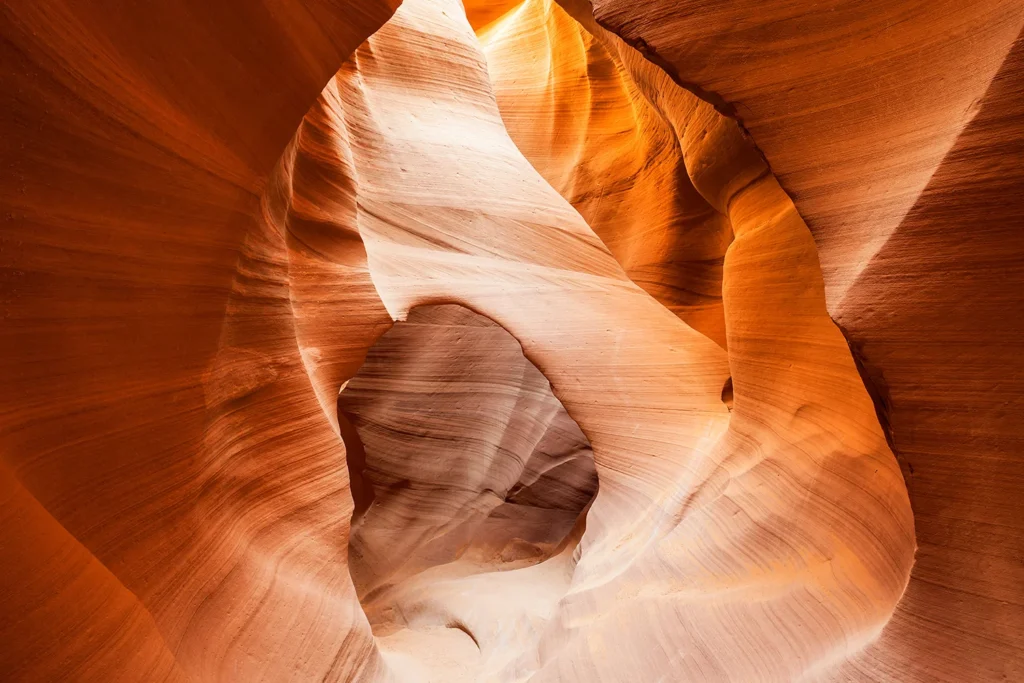
The Navajo people refer to the canyon as “the place where water runs through rocks,” and in essence, this phrase describes how this natural wonder came to be. The original narrow corridor was formed over thousands of years by water flowing over the surface of the soft, plastic sandstone characteristic of the region. Over time, the cracks were further eroded, deepening, widening, and smoothing the hard edges. This is when the canyon’s signature wavy shapes were carved into its walls.
The canyon’s shape continues to evolve, primarily due to rainfall, especially during the monsoon season. Rainwater rushes into the expansive basin with tremendous speed, then flows down the walls of the corridor, creating new grooves and sculpting the stone further.
Canyon characteristics
Antelope Canyon is sometimes referred to as Corkscrew Canyon, but both names can be a bit misleading. In reality, it consists of two separate slot canyons: Upper Antelope Canyon and Lower Antelope Canyon. Both are breathtaking and photograph beautifully, yet each has unique geographic features that give it its own distinctive character.
Upper Antelope Canyon
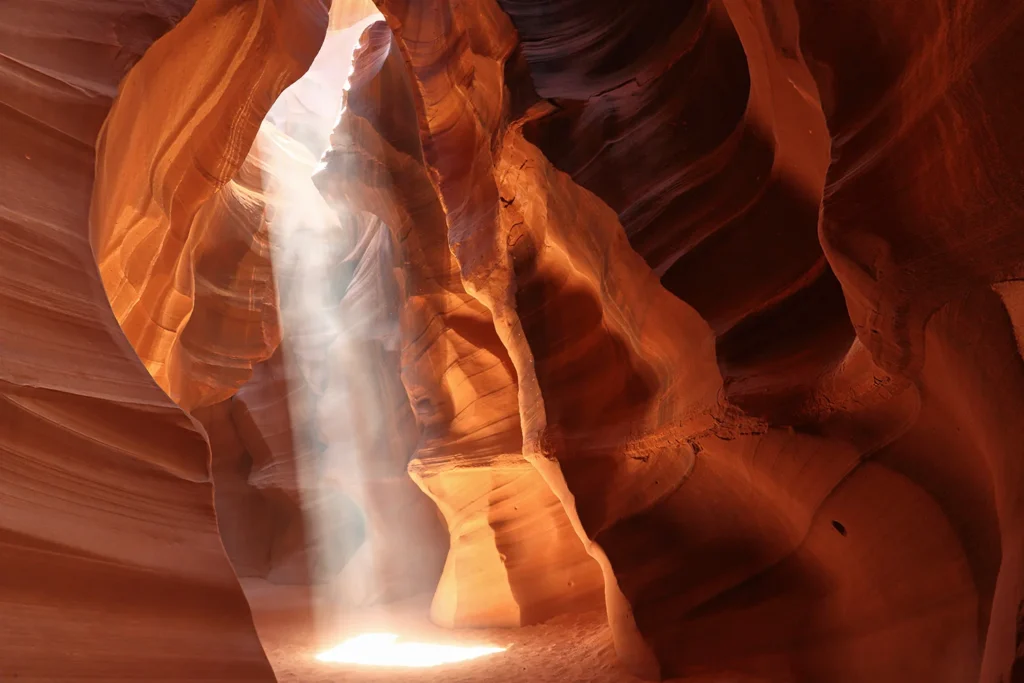
Upper Antelope Canyon is situated at an elevation of over 1,200 meters, with its walls rising almost 40 meters above the stream bed. The canyon forms the shape of the letter “A,” meaning it has a wide base and narrows towards the top. This is the most frequently chosen route for exploring Antelope Canyon. Both the entrance and the entire length of the corridor are at ground level, which means visitors don’t need to climb to experience its stunning beauty. This is particularly great news for those with mobility issues.
One of the biggest highlights of Upper Antelope Canyon is the famous Light Beams. These rays of light enter the canyon, illuminating the undulating stone walls, and are responsible for the characteristic interplay of light and shadow that defines the place. Additionally, just a few steps can change your perspective, revealing other layers of stone playing the leading role in this natural light show. Keep in mind that this phenomenon only occurs during the peak season, roughly from June to September, and even then, the light beams are only visible between 11:00 AM and 1:30 PM.
The good news is that even if you visit the canyon outside of peak season (and thus avoid the crowds), or on a cloudy day when you might miss the Light Beams, the canyon walls will still glow with vibrant colors and provide stunning photo opportunities.
Lower Antelope Canyon
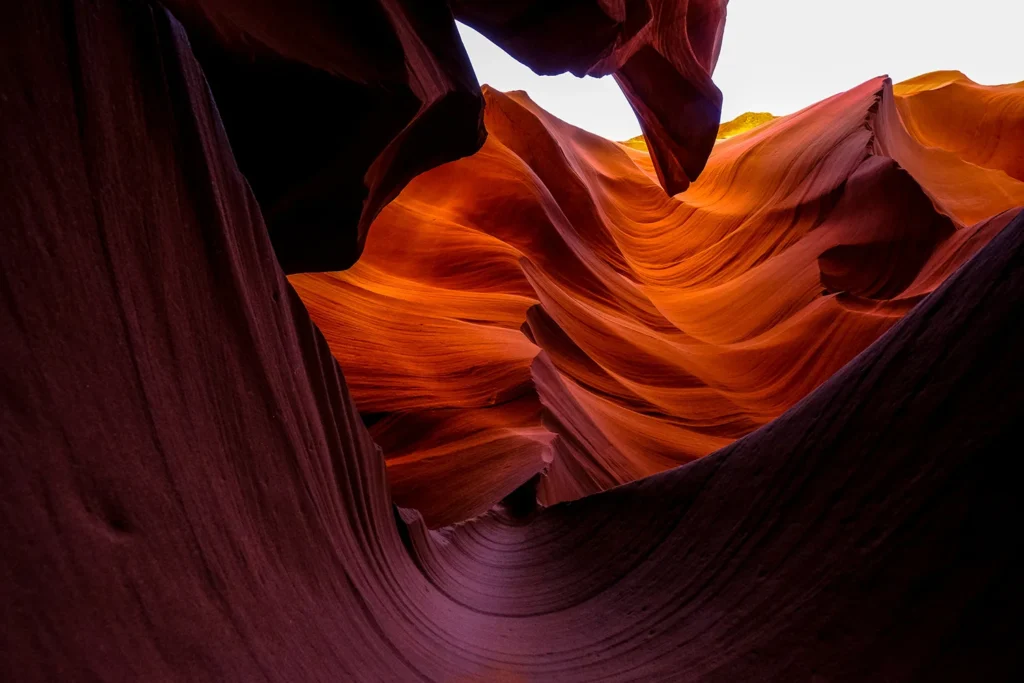
Lower Antelope Canyon is shaped like a “V,” meaning its narrow path widens as it opens up towards the sky. Many people say that this canyon boasts even more beautiful rock formations than its upper counterpart, yet it receives far fewer visitors. Why is that? The route is more challenging to access, requiring the use of several ladders, and you can’t enter the canyon from ground level. It is also narrower and longer. For many, this description might not deter them—in fact, the tight corridors and ladder climbs can add an extra thrill to the adventure.
Since fewer people visit Lower Antelope Canyon, it’s a better option if you’re dreaming of capturing that perfect photo without sharing your frame with other eager photographers. However, it’s worth noting that lighting in Lower Antelope Canyon can be a bit more challenging for photographers compared to the Upper Canyon. You’re unlikely to find the famous Light Beams here, but with some trial and error, you’ll still leave with a gallery full of photographic treasures.
Flash Floods
The primary reason that the canyon can only be visited with a guide is the risk of flash floods. What exactly is a flash flood? During monsoon rains or sudden, intense downpours, water doesn’t absorb into the rocky terrain but instead accumulates rapidly within the canyon. These rains also carry sediment and debris, which fall to the canyon floor. While it might not sound particularly dangerous, even seemingly mild rainfalls can trigger a violent flood, creating an extreme hazard for anyone inside.
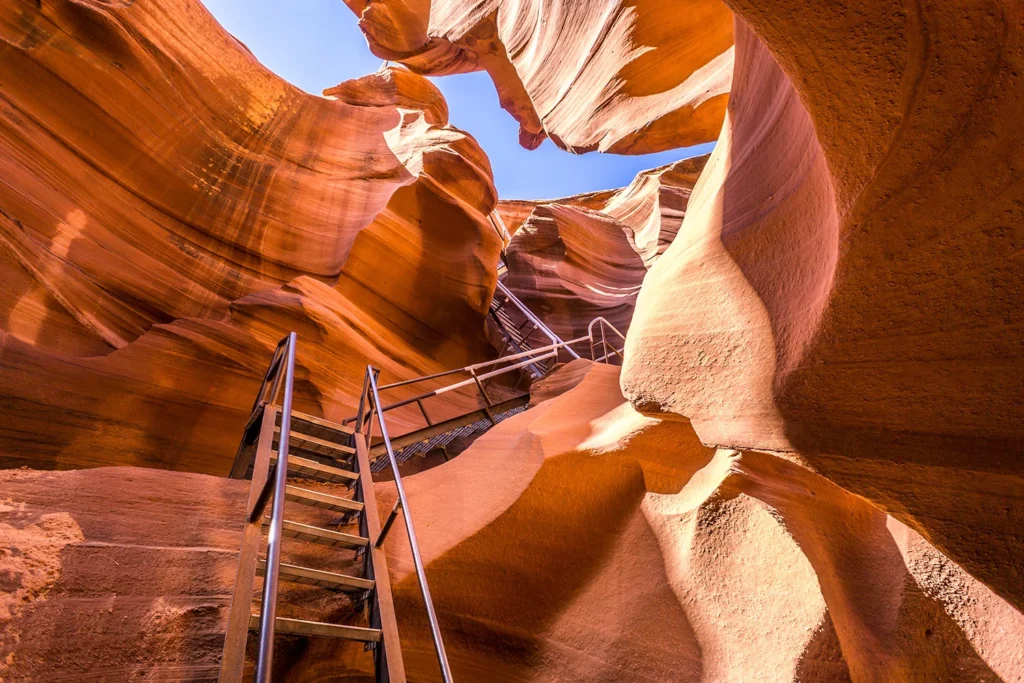
Such a flood can result in the canyon being closed for several months. For instance, in October 2006, after three days of heavy rain, Lower Antelope Canyon was shut down for five months. However, a much larger tragedy occurred nine years earlier. On August 12, 1997, a flash flood claimed the lives of 11 tourists from America and Europe. One of the reasons for the disaster was the sheer destructive power of the rushing water, which swept away the wooden ladders—the only exit route from the canyon at the time.
GOOD TO KNOW: There is much less risk of flooding in Upper Antelope Canyon, which is another reason why most tourists opt for this route. However, if you’re interested in exploring the less crowded but equally stunning Lower Antelope Canyon, don’t let fear hold you back. Since the tragic incident in 1997, steel steps anchored firmly into the rock have been installed in the lower corridor, and sirens have been added at the entrance to warn visitors in case of unexpected storms.
Visiting Antelope Canyon
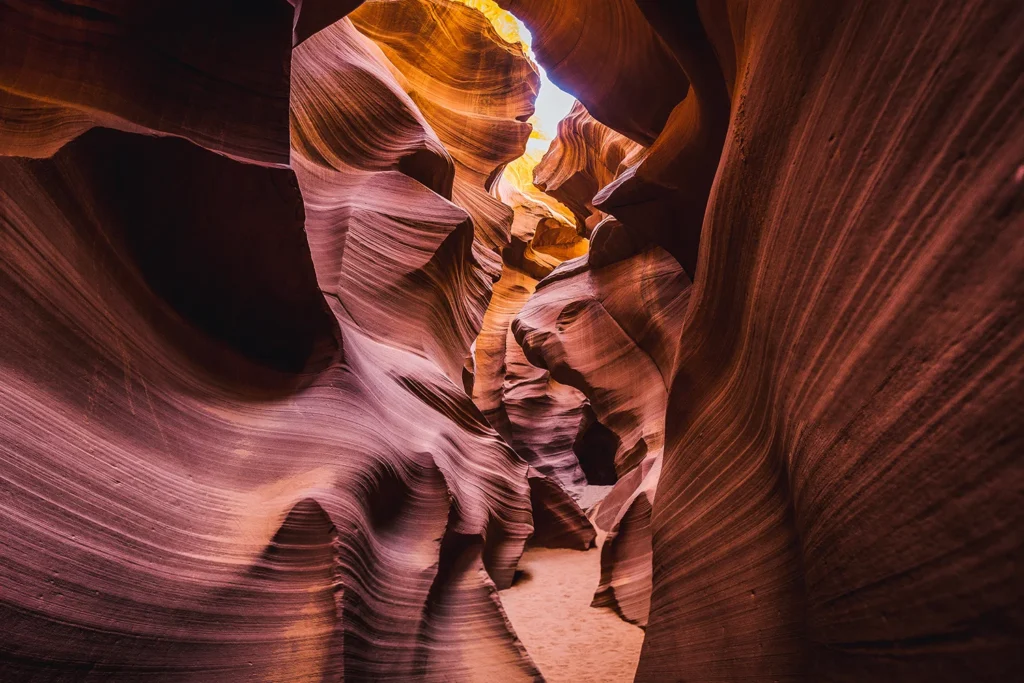
It’s undeniable that if you’re visiting the area around Page, Arizona, a trip to Antelope Canyon is a must. However, there are a few important things to keep in mind when organizing your visit. First and foremost, it’s worth emphasizing again that self-guided tours are not permitted. The only way to explore the canyon is by booking one of the guided tours, which are led by members of the Navajo Nation.
The most popular tour operators are Antelope Canyon Tours, Ken’s Tours, and Antelope Canyon Navajo Tours. Regardless of whether you choose the upper or lower canyon, tickets can be purchased online, for example, on this website. Booking your tour online is the only way to guarantee entry on your preferred date, especially during the peak season, where reservations often need to be made several weeks in advance.
What does the tour look like?
Your tour begins with boarding off-road vehicles that will take you through the desert terrain directly to the “gates” of Antelope Canyon. For many, this ride alone is an exciting adventure! Once inside the narrow stone passage, the assistance of an expert will be invaluable. A Navajo Tour Guide, a qualified local guide, not only ensures your safety but also highlights the most popular spots in the canyon, helps you notice the most beautiful rock formations, and offers photography tips so everyone can capture the beauty of this place as a keepsake. Additionally, the guide will share the canyon’s history and its cultural significance to the Navajo people.
A Few Useful Tips
Here are some important things to keep in mind before you start exploring the magic of Antelope Canyon:
- Anyone participating in a tour will be stepping onto Navajo Indian Reservation land, which means accepting the rules of the area. In the eyes of the native population, the canyon is a sacred place and deserves special respect. Therefore, make sure to leave no trace of your visit and resist the temptation to take any of the red sand underfoot, no matter how enticing its fiery color may be.
- Eating is prohibited on the trail, and surprisingly for some, so is the use of tripods or selfie sticks. The reason for this is simple. In many places, the passage through the canyon is very narrow, so groups must walk single file. Additionally, there is only one path through the middle of the canyon, meaning groups traveling in one direction must pass others returning the opposite way. As you can imagine, tripods set up everywhere would significantly hinder movement between the rock walls.
- Arizona is the only continental U.S. state that does not observe Daylight Saving Time. However, an exception exists on the lands belonging to the Navajo people, who adjust their clocks forward between March and November. This means that during the spring and summer months, Navajo land operates on a later time than the rest of Arizona. It’s important to keep this in mind when booking tours scheduled for specific times.
Neighboring Natural Wonders
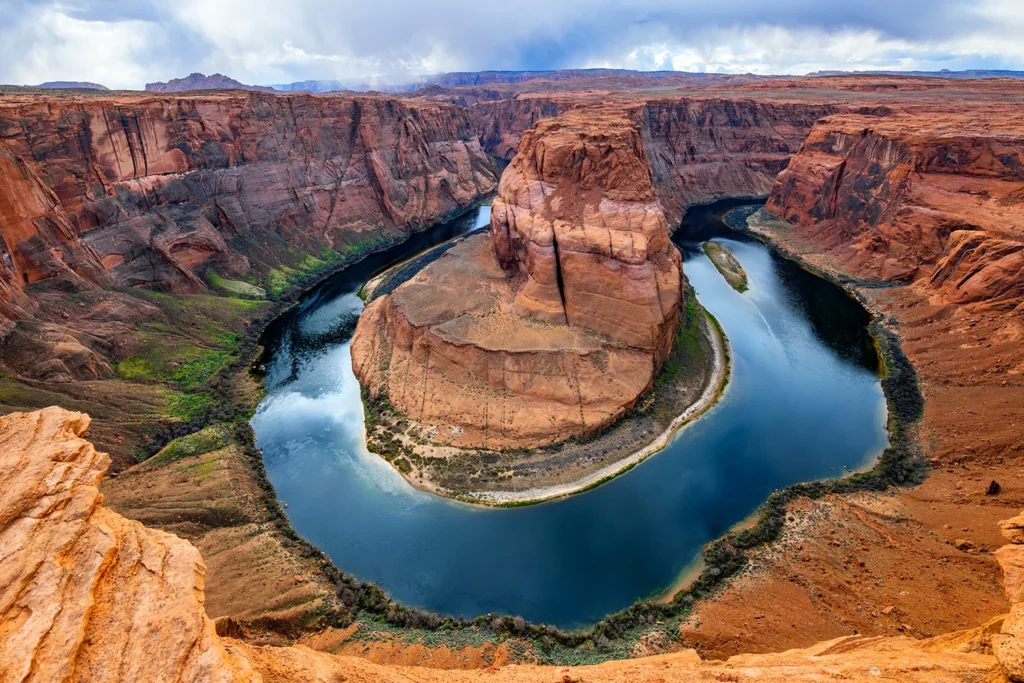
While taking a walk through the enchanting sandstone corridor of Antelope Canyon, it would be a shame to miss out on other nearby attractions that draw just as many nature lovers to Arizona. Just over 15 km from Antelope Canyon, photography enthusiasts flock to Horseshoe Bend, a meander in the Colorado River shaped like a horseshoe. It’s best viewed from a specially prepared viewpoint located over 300 meters above, offering an extraordinary perspective of the impressive river below.
Lake Powell, a man-made reservoir created by the construction of the controversial Glen Canyon Dam on the Colorado River, is another popular attraction. Nearby, you’ll find Tower Butte, a striking rock formation, and the Rainbow Bridge, a natural stone arch whose name refers to its shape, not its color. Speaking of northern Arizona, it’s impossible not to mention its most treasured gem, the Grand Canyon, which many travelers consider one of the most beautiful places in the world.
Practical information
- It is worth booking tickets for Antelope Canyon tours in advance. There are many tours available with experienced guides who will show you the most interesting spots, answer questions, and share fascinating facts about the areas being visited.
- Buy tickets on GetYourGuide